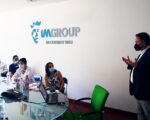‘As we have said many times, cloud is additive to our business, what we do in the cloud helps expand our on-premises business, and our enterprise-hardened software and experience provide a solid foundation for our work in the cloud,’ says NetApp CEO George Kurian.
Growth in sales of all-flash storage hardware and software and an increased presence in customers’ hybrid cloud environments continue to be a business driver for NetApp, which this week reported its third fiscal quarter 2021 financials. This became the company’s third consecutive quarter of revenue and billings growth.
NetApp’s third quarter fiscal success was broad-based, with notable strength in Americas enterprise, said George Kurian, CEO of the Sunnyvale, Calif.-based storage vendor.
The real star of the quarter was NetApp’s cloud and all-flash array businesses and how they work together for customers, Kurian told analysts Wednesday during his prepared remarks on the company’s quarterly financial analyst conference call.
“As we have said many times, cloud is additive to our business, what we do in the cloud helps expand our on-premises business, and our enterprise-hardened software and experience provide a solid foundation for our work in the cloud,” he said.
Cloud services annual recurring revenue grew to $237 million during the third fiscal quarter, an increase of 186 percent year over year, Kurian said.
“We saw good momentum across the portfolio, with Azure NetApp Files and Spot being the standout services, both delivering significant growth,” he said. “We continue to expand with existing customers while adding new enterprise and cloud-native customers. Our cloud services dollar-based net retention rate is a healthy 227 percent.”
Azure NetApp Files is a fully managed cloud service with full Azure portal integration and access via REST APIs and Azure SDKs, or software development kits.
NetApp Spot, based its June 2020 acquisition of Spot, provides AI and machine learning to predict when a spot instance on the public cloud will disappear in order to dynamically help applications find the lowest-cost spot instances.
“We are benefiting as customers move more tier-one workloads such as SAP to the cloud,” Kurian said. “Our cloud volumes service delivers the performance and availability required by mission-critical applications. To address the substantial cloud opportunity ahead, we are pulling forward investments with our public cloud partners, adding dedicated sales capacity and expanding our presence in additional regions.”
As a result, NetApp is confident it can make its long-term goal of achieving $1 billion in cloud annual recurring revenue in fiscal year 2025, Kurian said.
NetApp’s all-flash business grew 11 percent year over year to an annualized net revenue run rate of $2.6 billion, Kurian said.
“For the third consecutive quarter, we believe we outpaced the market, gaining share from competitors and converting our installed base from hybrid arrays to all-flash,” he said. “At the end of Q3, 27 percent of installed systems were all-flash, giving us plenty of headroom for continued growth.”
NetApp’s cloud services and flash systems are built on the same Ontap primary software foundation, Kurian said.
“This shared R&D foundation gives us significant leverage in our R&D investment,” he said. “We are able to innovate and test at cloud speed while bringing new functionality to the enterprise data center at a pace IT can absorb. This shared innovation also benefits customers, giving them a similar operating environment and consistent data management tools on-premises and in the cloud. It also enables them to move their data seamlessly to the right location at the right price at the right time.”
Calendar 2020 in general was a difficult year for the IT industry, Kurian said.
“We see reasons for optimism for calendar 2021 with expanding vaccine availability and improving public health conditions,” he said. “However, uncertainty about the new normal, as well as the tax and regulatory environments, remain. In uncertain markets, data is even more critical as organizations look to drive competitive advantage. And we are confident in our strategy and the strength of our business going forward.
During the question-and-answer period of the financial analyst call, when asked about his demand recovery expectations in the next two to three quarters, Kurian replied that NetApp has had three really good quarters and a regular January.
“So linearity was good throughout the past quarter,” he said. “[Fiscal] Q4, the early signs are very constructive. The pipeline’s strong. Our competitive position, I would not trade for anyone else’s in the market. So I feel really, really good about the opportunity ahead, not only in Q4 but going forward.”
NetApp is being prudent with its guidance because the IT industry is still in a COVID-19 coronavirus pandemic environment, Kurian said.
“While the vaccine availability provides incremental confidence, there are many other elements that need to come together to really give total line of sight to the new normal,” he said. “That includes tax, regulation, new policy decision frameworks from the government, the stimulus package, and other things. So we feel very good about the year. We feel really good about the pipeline heading into Q4. Our competitive position is strong and differentiated as we have demonstrated with share gains for three successive quarters. I think we are trying to balance the really good confidence in our business with the fact that we’re still operating in a pandemic environment.”
When asked about all-flash array sales growth going forward, Kurian said NetApp feels very good about the opportunity.
“What we are feeling very, very good about is the fact that we’ve demonstrated share gains,” he said. “We are not demonstrating the rate of penetration of the market and the rate of share gains without winning net-new customers and net-new workloads. Yes, installed base continues to be an opportunity, but what I feel really good about is the fact that we are growing at the expense of the competition this year.”
Kurian said the aggregate all-flash storage array market continues to get better and that the macro trends in calendar 2021 should improve over last year, although the timing is uncertain.
“Within our overall portfolio, we see all-flash continuing to be a greater part of the mix, especially as newer technologies that make flash more cost-effective comes to market. … We don’t think flash will be 100 percent of the storage market,” he said. “We think it will be a substantial percentage. And we think that that transition affords us opportunity to gain share of new customers as well as to sell more software-rich, higher-margin configurations to customers.”
For its third fiscal quarter 2021, NetApp reported total revenue of $1.47 billion, up about 5 percent over the $1.40 billion the company reported for its third fiscal quarter of 2020. That included product revenue of $775 million, down about 1.5 percent; software maintenance revenue of $334 million, up 27.0 percent; and hardware maintenance and other services revenue of $361 million, up 2.0 percent.
Within the revenue figure, NetApp’s all-flash storage revenue reached $652 million, which was up 11 percent over last year. Public cloud services delivered $237 million in annual recurring revenue, which was up 186 percent year over year.
About 76 percent of NetApp’s revenue came via indirect channels, down slightly from last year’s 79 percent.
Net income for the quarter on a GAAP basis was reported as $182 million, or 82 cents per share, down from last year’s $277 million, or $1.23 per share. On a non-GAAP basis, net income was $250 million, or $1.10 per share, down slightly from last year’s $265 million, or $1.16 per share.
NetApp beat analysts’ expectations for both GAAP and non-GAAP earnings per share by 9 cents, and beat revenue expectations by $40 million, according to Seeking Alpha.
Looking forward, NetApp expects fourth fiscal quarter 2021 revenue to range between $1.44 billion and $1.54 billion which, at the midpoint, reflects a 6 percent increase in revenue year over year. The company also expects non-GAAP earnings per share for the fourth quarter to range between $1.06 and $1.14 per share.








